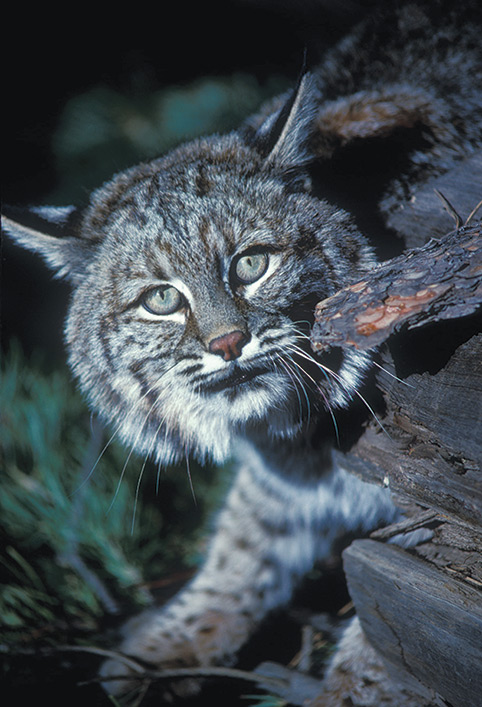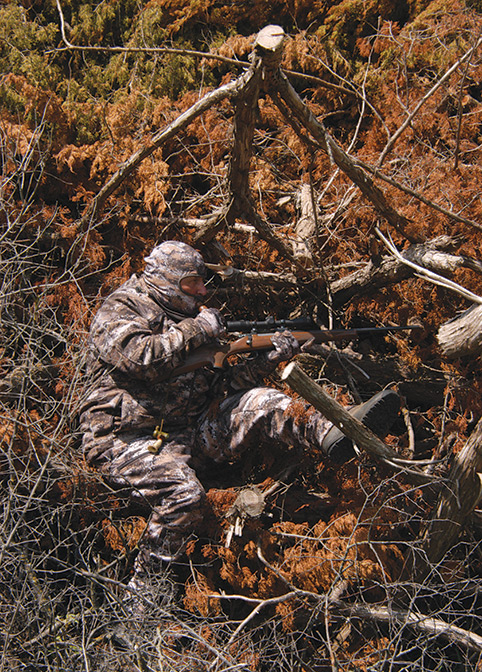 Predator Hunting: High-Dollar Bobcats
Predator Hunting: High-Dollar Bobcats
By Predator Hunting Editor Judd Cooney

The coyote was struggling to tear a chunk of meat off the frozen carcass, completely unaware of my prone form nestled 200 yards away behind a clump of oak brush on the adjacent ridge. I settled the crosshairs on a shoulder, a slam dunk for the Kimber .22-250. But I didn’t take the shot. Instead, I raised the barrel and peered through the 3-9X scope into the branches of a Ponderosa pine 100 yards farther up the ridge and found a big tom bobcat literally out on a limb, nonchalantly watching the coyote working the carcass.
I settled the crosshairs and applied the final pressure to the trigger, sending a 52-grain Sierra hollow point on its way. The big cat tumbled out of the tree, and I jacked another round into the chamber, waited a couple of seconds to make sure the cat stayed put, and then swung the rifle back toward where the coyote had been feeding. I only caught a glimpse of fur zigzagging away through the brush.
I hate seeing a coyote escape that way. But I’d opted for a $500 bobcat pelt over a $70 coyote, and finding that cat perched directly behind the coyote wasn’t a stroke of luck, not by any means. Two weeks before, I’d used my snowmobile to tow half of a horse carcass to where I could glass it from a county road a half-mile away. It was an open slope, and I located the bait carefully where there was little likelihood of anyone else just happening to spot it, on private land where I was the only one with permission to hunt predators.
A week after placing the bait I glassed a coyote on the carcass, made a stalk behind the adjacent ridge, crawled into shooting position in a hide I had already arranged, got a solid rest, and flattened the coyote with an easy 200-yard shot. Before I walked down to retrieve the coyote, I looped away from the hidey hole so my tracks in the snow wouldn’t lead in a direct line of sight from the carcass to the hide. A trail like that can focus the next wary, sharp-eyed predator on your shooting position.
When I placed the bait with the snowmobile, I also made sure to leave only one packed trail, this one angling across 50 yards below my stand. A spooked coyote will generally run along the path of least resistance, and if there is more than one coyote around a bait, I take the farthest shot first. Then, the panicked survivor or survivors take that fastest route right where I want them. Doing this, I once shot the third coyote off a bait within 30 yards of my ambush location—after dropping the first one at 300 yards and the second at 150 yards. But there had been another foot of snow since I had placed this bait, so the packed escape trail from the bait was buried. Otherwise, I might have got a shot at the coyote, too.
When I went to retrieve that first coyote the week before, I saw large bobcat tracks around the carcass and figured I might get a prized fur by being even more devious. Only a large tom would venture out into the open in such a situation.
Later that day, I dragged the hindquarter of a steer up into the timber above the half-a-horse. I hoisted it into a low-limbed Ponderosa pine out of reach of any coyote but an easy and safe place for a cat to feed. It was also a clear shot from my hidey hole on the adjacent ridge.
One week and two coyote kills later, I spotted the bobcat feeding on the hung hindquarters just after daylight. A little extra work had put the cat right where I wanted it, out-of-the-box thinking that paid with a prime, high-dollar pelt.
With bobcat populations on the rise and the premier pelts again fetching sky-high prices, it may behoove a predator hunter to put a bit of extra thought and effort into adding a bobcat pelt or two to his collection. But bobcat hunting—whether calling, spot and stalk, tracking and trailing, or over bait—is still a game of patience and perseverance. And that’s a game not everyone is willing to play.
A good illustration of this occurred when prime cat pelts were averaging over $500. I was having breakfast at a local diner, and a rancher I knew stopped in and joined me for morning coffee.
During our ensuing conversation, he told me he had seen a bobcat feeding on a mule deer carcass off the backcountry gravel road that ran between town and his ranch. He figured the “forky” buck had either been hit by a car and made it that far off the road before expiring or more likely had been wounded and lost during a recently closed gun season. He had seen the cat twice over the past week, within yards of a dense oakbrush thicket at the head of a rocky canyon, ideal cat habitat.
Like most ranchers, he carried a rifle in the truck, and when he saw the cat the second time, he pulled over.
Generally, bobcats are less skittish than coyotes. But he figured this one had been shot at before because when a car coming the other way on the road got within a quarter-mile, the cat faded back into the brush. He wasn’t a hardcore predator hunter and only gave it 20 minutes or so to reappear. When it didn’t, he drove on into town. He told me where the carcass was located and added I was welcome to try my luck.
Later that day, I easily located the carcass. Then I backed up the road to a ridge a half-mile away, where I confirmed that I could glass the location with a 45X spotting scope. The following morning, I was back on that ridge at daylight with the scope. If the cat had remained lying behind the carcass, I would have missed it even with the powerful optics. Fortunately (at least for me) it stood up to scan the area.

From where I sat, I could drive down off the ridge into an adjacent valley bottom with no chance of spooking the feeding cat, and once there, I could hike up the backside of the ridge overlooking the clearing. Sounded like a plan, and the cat was still gnawing on the frozen carcass a half-hour later when I centered the crosshairs at 250 yards. The stalk had been so easy I almost felt guilty as I gently squeezed the trigger.
I know predator callers who take untold numbers of fox and coyotes in prime bobcat country yet never see let alone get a shot at a bobcat. I say that’s on them.
A pro staff turkey caller who spent most of his hunting life running and gunning Southern gobblers once lamented that he never called in Iowa turkeys. “Ha!” I told him. “You leave before they arrive!”
Bobcats are even stealthier. A rare cat may come charging to my calls, but most sneak in to find out what is causing the ruckus before exposing themselves. This is especially true where cats live with coyotes, wolves or bears.
One fine day I was calling on the edge of a brushy canyon with a good view down into jumbled boulders, dense oakbrush and cedars on a facing slope 300 yards away. I’d been calling intermittently for 15 minutes or so when I caught a hint of movement at the top of the rimrock on the far side of the canyon. It took another minute with 10-power binoculars to make out the camouflaged form of a bobcat sitting on its haunches in the shade of a low juniper bush.
At the time, bobcat pelts from that region of Texas weren’t worth much, so I decided to just sit tight and see what the complacent cat might do. I coaxed every wheedling, whimpering sound I could muster out of three different calls. The cat never moved a muscle, just sat there staring my way.
After 45 minutes of this, I gave up on the calls and started lip squeaking. I figured there was no way the cat could hear it at that distance, but I was out of other ideas.
The cat promptly stood and then slowly worked its way down through the rocks and brush. I ended up shooting it in the wide open 30 yards below me.
Patience and perseverance are the watchwords for bobcat calling. In good cat country, I generally stay on stand for an hour, and I have shot a number of cats a good half-hour or longer after I started calling. Motion decoys are especially helpful with bobcats, and nowadays I rarely attempt to call cats without one.
With the high price of premiere cats, it’s more important than ever to shoot a “fur friendly” cartridge, a load that will make clean kills at reasonably long range without shredding everything twixt nose and tail with a closer hit. My preference leans toward hollow-point match bullets. They are deadly accurate, make clean kills at long range, and the fur damage at closer range can usually be repaired with needle and thread. I use the same basic load in my .220 Swift, .22-250, and .223, a load I worked up a long time ago.
Even though I never stop experimenting, I still haven’t found anything better.
Speaking of needle and thread, when I was buying fur full-time in Colorado, New Mexico and Utah, the careless fur-handling of predator hunters put a lot of extra jingle in my pocket. When someone brought me a prime bobcat pelt with dried blood and obvious bullet damage, I dropped my offer to half of what it would have been for the same pelt handled properly by a more skilled hunter or trapper.
Then I cleaned the fur, pulled out needle and thread, and got busy.
Always wash a bloody pelt gently in cold water with a bit of mild laundry detergent. Never use warm or hot water as this can set the blood stain in the fur. Rinse in plain cold water several times, and then dry the fur with towels, a fan, or a hair dryer set to blow-dry with no heat.
Carefully trim any meat or other tissue from around the bullet hole, and take your time fitting the torn edges together. Make small stitches as close to the edge of the tear as possible, being sure not to bunch up the hide or pull any hair into the stitches, as that leaves a lump.
Use a good wooden stretcher to dry a properly fleshed pelt (you don’t have to be a trapper to order a half-dozen from a trapping supply house). Metal stretchers can rust and stain fur, so avoid those.
Put the hide on the stretcher skin-out until the leather loses its tackiness. In a dry environment, this may happen overnight. Then pull it off the stretcher, turn it fur-out, and put it back on the stretcher to finish drying. If you let the skin get too dry before pulling it to turn, it may tear. If you are worried, wrap the skin-out hide in warm, damp towels until it is pliable.
Combing and brushing out the dry fur can make a good pelt look great. Holding the pelt by the nose and lower end and gently “popping” it can add additional puff to the fur.
If fur handling isn’t your thing, find a local trapper who works at his trade and pay him to take care of your cats. If you hunt in an area with good fur, it will be money well spent.